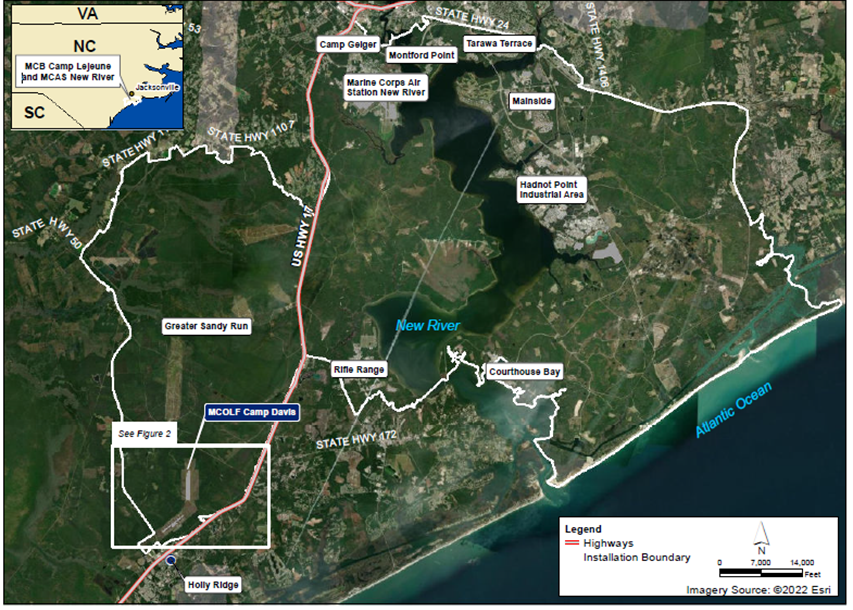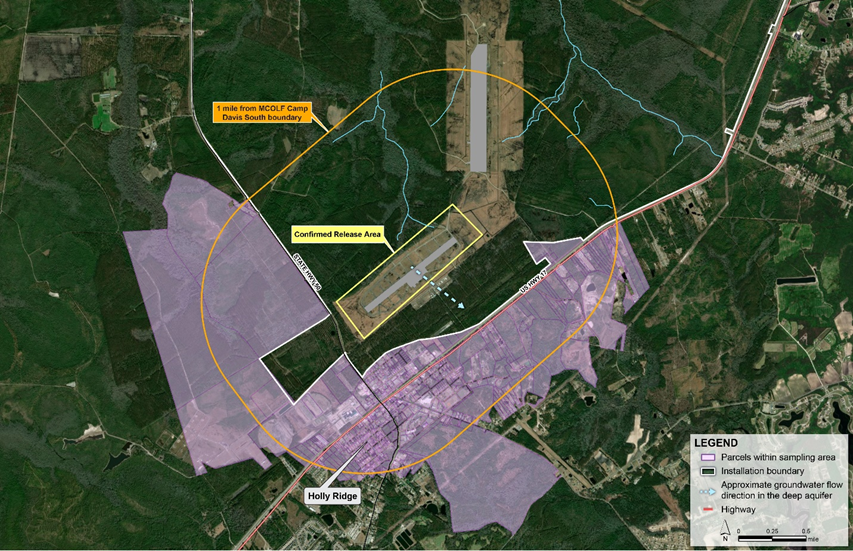In 2021, the Navy sampled drinking water wells near Marine Corps Outlying Landing Field (MCOLF) Camp Davis South to test for certain per- and poly fluoroalkyl substances, commonly known as PFAS. For questions about this sampling, please contact the MCIEAST-MCB Camp Lejeune COMMSTRAT by phone at 910-451-5655 or by email: mcieastcommstrat@usmc.mil.
Introduction
Per- and polyfluoroalkyl substances (PFAS) are a family of thousands of different substances which have been widely used in industrial and consumer products since the 1950s. PFAS have been used in many household and industrial products because of their stain- and water-repellent properties. PFAS are now present virtually everywhere in the world. The Navy and Department of Defense (DoD) have developed proactive policies to address past releases of PFAS, including perfluorooctanoic acid (PFOA) and perfluorooctane sulfonic acid (PFOS), at installations nationwide.
The most common activity that could have resulted in the historical release of PFOS, PFOA, and other PFAS to the environment at Navy and Marine Corps installations is the use of firefighting foam (specifically, aqueous film-forming foam, or AFFF) for testing, training, firefighting, and other lifesaving emergency responses. Once these compounds are released, many of them tend to stay in the environment.
On April 10, 2024, the EPA announced a final rule on drinking water standards for certain PFAS under the Safe Drinking Water Act (SDWA). This rule applies to all regulated drinking water suppliers, including the DoD. DoD remains committed to fulfilling our PFAS-related cleanup responsibilities and will take necessary actions to implement the rule in accordance with the federal cleanup law, the Comprehensive Environmental Response, Compensation, and Liability Act (CERCLA). For now, the Navy is continuing to follow the policy it issued in June 2016 to conduct investigations at installations where there has been a known or suspected release of PFAS to the environment. The first priority with these investigations is to identify and access PFOA and PFOS concentrations in drinking water wells above 70 parts per trillion (ppt)*, individually or combined, as a result of Navy operations. DoD, including the Navy, is transitioning to PFAS-free alternatives to AFFF. Until that transition is complete, the Navy will use AFFF with lower concentrations of PFOA and PFOS and will work to reduce releases of AFFF to the environment.
*70 ppt for PFOA and PFOS is the 2016 EPA lifetime drinking water health advisory level for PFOA and PFOS, individually or combined.
Off-Base Drinking Water Sampling at Marine Corps Outlying Landing Field (MCOLF) Camp Davis South – Site 111 (Figure 1)
Based on Installation Restoration studies, MCOLF Camp Davis South was identified for PFAS to potentially migrate off-base and impact drinking water wells in the direction of groundwater flow, and PFOA and PFOS were detected in shallow groundwater above 70 ppt. This area is in the Greater Sandy Run Area of Marine Corps Base Camp Lejeune and off-Base residential areas are present within 1 mile of the surficial aquifer monitoring wells with PFOA and/or PFOS detections (Figure 1). When a known or suspected release of PFAS is identified on a Navy or a Marine Corps installation and groundwater is used as drinking water, a sampling area is established 1 mile in the direction that groundwater flows away from the known or suspected release area. The Navy would offer sampling to all property owners and tenants whose property is within the sampling area and whose drinking water is supplied by groundwater.
Figure 1: Location Map of MCOLF Camp Davis South

The Navy has sampled drinking water wells located in the sampling area (Figure 2). Records indicate that some properties within the sampling area (Figure 2) are provided drinking water by the Onslow Water and Sewer Authority (ONWASA), a public water system. If you live within the sampling area and your drinking water is provided by a public water system, the Navy did not sample your drinking water. Property owners and tenants may contact ONWASA with any questions regarding treatment and testing of their publicly provided drinking water.
Figure 2: Sampling Area

Potential Actions Based on Off-Base Drinking Water Sampling Results
The Navy and Marine Corps would provide bottled water for drinking and cooking to any property in the sampling area with a drinking water well containing PFOA and/or PFOS above 70 ppt and without an alternate drinking water source. The Navy and Marine Corps would continue to provide bottled water until a permanent environmental response is implemented.
2021 Off-Base Drinking Water Sampling Results
In March 2021, the Navy began sampling drinking water from wells within the sampling area near MCOLF Camp Davis South. The Navy received the preliminary results from the off-base drinking water sampling approximately 30 days after collecting the samples. We notified the property owners and tenants of their drinking water sampling results, none of which contained PFOA and/or PFOS above 70 ppt. Table 1 summarizes the drinking water sampling results to date. We called each property owner and tenant upon receipt of their preliminary results, and we mailed final laboratory results to each property owner and tenant.
| Table 1. MCB Camp Lejeune – Off-Base Drinking Water Results as of December 2023 |
| Sample Date |
Number of Wells Sampled |
Number of wells with no detections of PFOA or PFOS |
Number of wells with detections of PFOA and/or PFOS below 70 ppt |
Number of wells with detections of PFOA and/or PFOS above 70 ppt |
|
March/April 2021
|
7
|
6
|
1
|
0
|
|
June 2021
|
4
|
4
|
0
|
0
|
|
September 2021
|
1
|
1
|
0
|
0
|
Identification of PFAS Releases at MCOLF Camp Davis South
In 2018, a Basewide Preliminary Assessment (PA) for potential PFAS releases to the environment was conducted. Of the 213 evaluated areas, the PA recommended 52 areas, including MCOLF Camp Davis South, for site inspection (SI) activities to evaluate the presence of PFAS in soil and groundwater. The SI activities at MCOLF Camp Davis were conducted in 2020 and the SI report was finalized in January 2022. At MCOLF Camp Davis South, PFOA and PFOS were detected in shallow groundwater above 70 ppt. Based on the SI results, MCOLF Camp Davis was identified for PFAS to potentially migrate off-base and impact drinking water wells in the direction of groundwater flow. This area is located in the Greater Sandy Run Annex portion of Marine Corps Base Camp Lejeune and Marine Corps Air Station New River and off-Base residential areas are present within 1 mile of the surficial aquifer monitoring wells with PFOA and/or PFOS detections (Figure 2). Following the SI and the off-Base drinking water evaluation summarized above, the Navy and Marine Corps conducted additional groundwater evaluation at Site 111 in June 202, particularly to evaluate if PFAS were present in the deeper aquifer typically utilized for water supply, the Castle Hayne aquifer. PFAS were not detected above screening levels in samples collected from monitoring wells screened in the Castle Hayne aquifer.
In July 2022, the Navy and Marine Corps prepared a work plan to conduct a Remedial Investigation (RI) at Site 111 to delineate the nature and extent of PFAS impacts and to evaluate potential impacts to human health and the environment. RI field activities were initiated in August 2022 and are expected to be completed in 2024, with the RI report to follow.
In February 2024, the Navy and Marine Corps shared the Site 111 PFAS investigation summary with the Camp Lejeune Restoration Advisory Board, which is a joint Department of Defense (DOD), North Carolina Department of Environmental Quality (NCDEQ) and U.S. Environmental Protection Agency (EPA) initiative to increase participation by local community members in the cleanup process at military installations. The RAB provides a forum through which local communities, installations and regulatory agencies work together in an atmosphere that encourages discussion and exchange of information. The Camp Lejeune Restoration Advisory Board (RAB) typically meets at Coastal Carolina Community College approximately quarterly. For more information and schedule for next RAB meeting, please see https://www.lejeune.marines.mil/Offices-Staff/Environmental-Mgmt/Restoration-Advisory-Board/.
MCOLF Camp Davis South Drinking Water Sampling Documents
Additional Resources
Links